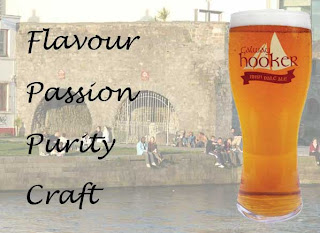First up is Oyster Stout, brewed by the Porterhouse Brewing Company from Dublin. This beer has oysters added to the brewing process, this adds what the label describes as a discernible yet unidentifiable note. I will be sampling the 330ml bottle, ABV 5.2%. So lets try it out.
It pours a jet black with a good tan head that dissipates quickly, but you are left with a thin line of creamy head. The aroma is of rich roasted malt, no oysters apparent on the nose! The beer is full bodied with a very smooth creamy mounthfeel, a low level of carbonation allows all the flavours to come nicely to the fore. The roasted malt dominates the taste however there is a nice balance of hop flavour. You also get the nice astringency in the aftertaste from the black malt. Funnily enough there is a perculiar character to the flavour that I cannot put my finger on, this must be the 'discernible yet unidentifiable note' added by the oysters. Good ingredient information is provided on the label:
Hops: Galena, Nugget, East Kent Goldings
Certainly a beer worth trying to emulate as a homebrew, however I would not try and tackle the oyster addition!
Overall a very nice Irish stout, the flavouring is well balanced and everything comes through in a nice subtle way. I have had this beer both on draught and in bottle and I would highly recommend both.
The second stout for today is also by the Porterhouse Brewing Company from Dublin, this is their Wrasslers XXXX Full Stout. The label carries a warning to tell the drinker that this is a traditional stout, dry with lots of roast malt flavour and hop bitterness. This is a 330ml bottle, 5.7%, bottle conditioned and unpasteurized.
The beer certainly looks quite different to their Oyster Stout, it pours with a dark tan head, which also quickly dissipates, leaving a very thin layer of head. The aroma is surprinsingly very subtle, you can certainly get the roasted malt, however the surprising element is how the aroma hops are to the fore(Goldings according to the bottle), overall a lovely balanced aroma. The mouthfeel is also quite different to the Oyster Stout, it is only medium bodied, with a higher level of carbonation and also a sharper taste. The flavour is of roasted malts and bittering hops. The key to the flavour of this beer is to let it sit on the palate a moment before swallowing, you then get a real sense of the combination of malts and hops. It is a quite complex beer and I am afraid that being served straight from my fridge it is probably a little cold, allow this to warn up a bit and it would be a even better. Should you wish to try and emulate this beer at home, good ingredients information is provided for the homebrewer:
Grain: Pale malt, Roast Barley, Black malt, Flaked Barley
Hops: Galena, Nugget, East Kent Goldings
Overall a very nice stout, possibly not as smooth and velvety as the Oyster Stout, but certainly one that deserves appreciation. My only critique would be that I feel that the level of carbonation achieved through bottle conditioning is a little to high. But this is certainly a very good Irish stout that you should seek out. I have heard, although I have not tried it myself, that the draught version of this beer is fantastic.
These two stouts are IMHO vastly superior to Guinness in terms of their complexity and flavour, however I still enjoy draught Guinness and will continue to do so. What these beers show is that there is still diversity in Irish brewed beer, unfortunatley at the moment it seems that you need to look a bit harder to find it. I would guess that the vast majority of the Irish stout drinkers have never heard of Wrasslers, never mind a stout brewed with oysters.
















